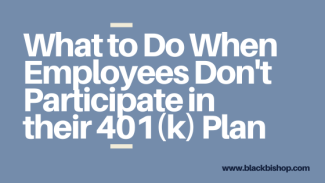
What to Do When Employees Don’t Participate in their 401(k) Plan
So, what do you do if your eligible employees don’t participate in their plan?
A 401(k plan is only a benefit to your employees if they actually participate. If you find that you have low participation in your plan, there are a few things you can do to encourage higher participation.
Understanding Participation Rates
The term “participation rate” simply refers to the percentage of eligible employees who are deferring part of their pay into their 401(k) plan.
Published in December of 2021, the 2021 How America Saves Report by Vanguard (based on 2020 data) revealed a current average participation rate of nearly 73 percent.
This number has been steadily increasing over the years, with the biggest bump in the last few years since the 2019 SECURE Act was passed.
Just as important as participation rates however (or perhaps even more important), are plan deferral rates which have a significant effect on overall savings rates. Deferral rates refer to the percentage of pay a participant is deferring.
The average 401(k) contribution deferral rate was 7.3% of pay in 2020, according to Vanguard 401(k) plan data. Many professionals will note that while this number has been steadily increasing over the years, this is too low to get participants to their retirement savings goals.
The Importance of Having Employees Participate in the Plan
There are several benefits to having employees participating in your company 401(k) plan.
1. Participation in the plan makes the benefit (and the cost to you as an employer) an actual benefit to employees. And if you have key employees and highly compensated employees, the more you can encourage employees to defer, the better this bodes for the required compliance tests results.
2. Participation helps to provide future financial security for employees so that at some point they can actually retire.
3. Studies show that employees who feel educated and on track for retirement (financially on-track) are more productive and less stressed at work.
So How Can You Encourage Higher Participation and Deferral Rates?
Here are a few steps you might consider that could help encourage more employees to participate in their plan (as well as increase deferral rates).
1. Implement an auto-enrollment feature where all newly eligible participants are automatically enrolled in the plan (and can opt-out if desired). (If you currently offer this, consider increasing the starting deferral rate.) For more information on auto-enrollment, contact us and we’d be happy to email you a free guide from the Department of Labor Guide titled, “Automatic Enrollment 401(k) Plans for Small Business.”
2. Implement an auto-escalation feature where the deferral rate automatically increases each year by a percentage point until it reaches a specific percentage (say 10%). (If you currently offer this, consider increasing the cap on the deferral rate.)
3. Evaluate the match on the plan. (If you don’t offer a match – consider adding one.) If your match is 100% of the first 3% of deferrals – your average deferral rate will most likely be 3%. If you change your match to 50% of the first 6%, you’ll find your average deferral rate will likely increase to 6%. Doing this change doesn’t cost you more, but encourages participants to defer more to get the full match.
4. Poll employees to find out: what questions they have about their plan, preferred method of communication, topics they’re interested in, etc., then build a custom education program that encourages plan participation and savings.
5. Consider offering educational webinars or seminars on basic topics such as budgeting, investing 101, dollar-cost averaging, etc.) In addition to group education, consider offering 1-1 education (and/or advice) meetings for employees.
If you have more questions on setting participation and deferral goals for your plan, polling employees, building a custom education program, or anything else discussed in this article, contact us and we’d be happy to set up a time to chat.

